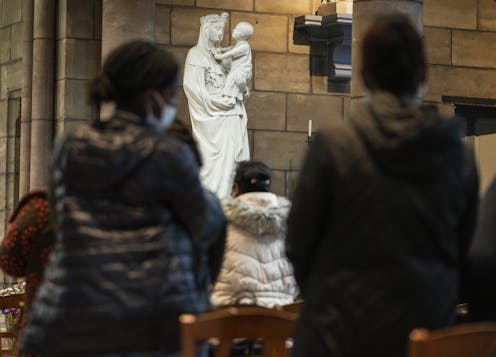The Catholic Church sex abuse crisis: 4 essential reads
- Written by Molly Jackson, Religion and Ethics Editor

Revelations about sexual abuse in the Catholic Church have been emerging for decades. But in the seemingly never-ending stream of investigations and accusations, some stand out.
That will likely be true of the report[1] released Oct. 5, 2021, which estimates that more than 200,000 children have been abused by clergy in France since 1950.
The authors of the French study spent three years[2] reviewing testimony from nearly 6,500 people. They then came up with their overall projection based on broader demographic data, and made dozens of recommendations: from case-by-case compensation to more sweeping reforms, such as that French bishops consider ordaining married men and giving women a louder voice in church decision-making.
The French report’s specific findings may be new, but the underlying issues are not. Here are some of The Conversation’s many articles examining the Catholic sex abuse crisis over the years, both its roots and the potential routes for reform.
1. Years of scandal
High-profile reports have consistently put the crisis in headlines for the past 20 years, particularly The Boston Globe’s famous “Spotlight” investigation in 2002 and the film it inspired in 2015.
But the paper trail documenting patterns of abuse – and cover-ups – goes back to at least the 1950s[4], according to Brian Clites[5], an expert on clergy sex abuse. That’s when U.S. bishops began referring priests to church-run treatment centers, rather than reporting abuse to independent authorities. “Hush money” payouts followed.
By the 1990s, as lawsuits mounted, “the national outcry forced dioceses across the country to create public standards for how they were handling abuse accusations,” Clites writes, “and American bishops launched new marketing campaigns to regain trust.”
Read more: The Catholic Church's grim history of ignoring priestly pedophilia – and silencing would-be whistleblowers[6]
2. Speaking up – and out
One major barrier to bringing abusers to justice, many experts argue[7], are the church’s hierarchy and canon laws, which regulate the church and its members.
But in 2019[8], Pope Francis modified the “Rule of Pontifical Secrecy,” which required that sensitive information about the church be kept confidential. Over the years, critics alleged that the policy allowed officials[9] to withhold information about sexual abuse cases, even from victims or legal authorities. Francis’ announcement lifted the rule for three situations: sexual abuse of minors or vulnerable persons, failure to report or efforts to cover up such abuse, and possession of child pornography by a cleric.
Even with this change, however, transparency may prove elusive, argues law professor Christine P. Bartholomew[10]. She outlines other practices[11] that can be used to conceal information and work around mandatory reporting requirements.
Read more: Pope ends a secrecy rule for Catholic sexual abuse cases, but for victims many barriers to justice remain[12]
3. Celibacy controversy
Other analysts trying to understand the roots of the sex abuse crisis focus on the rules of the priesthood itself – especially that priests be male and celibate.
But it hasn’t always been that clear cut. Kim Haines-Eitzen[14], an expert on early Christianity, outlines how views on marriage have shifted[15] ever since the first century. Saint Paul seemed to endorse marriage “reluctantly,” she writes, as “an acceptable choice for those who cannot control themselves.”
Attitudes toward sex and marriage continued to cause controversy for centuries, contributing to schisms between the Catholic and Eastern Orthodox Church, and later the Protestant Reformation. This is still the case today, as some Catholics advocate that married men be allowed to become priests[16].
Read more: How views on priestly celibacy changed in Christian history[17]
4. Change is possible
Changing a 2,000-year-old institution is hard, but not out of reach.
As a scholar of religious change, Melissa Wilde[19] pinpoints moments when the Catholic Church changed course[20]. Chief among them was Vatican II, the seminal church council in the 1960s that made significant reforms to worship, such as conducting the Mass in parishioners’ own language, rather than Latin.
With the church mired in crises, “the church needs more than reflection,” she argues. “It needs another council.”
Read more: The Catholic Church resists change – but Vatican II shows it's possible[21]
Editor’s note: This story is a roundup of articles from The Conversation’s archives.
References
- ^ the report (www.ciase.fr)
- ^ spent three years (www.nytimes.com)
- ^ AP Photo/Andrew Medichini (www.apimages.com)
- ^ goes back to at least the 1950s (theconversation.com)
- ^ Brian Clites (artsci.case.edu)
- ^ The Catholic Church's grim history of ignoring priestly pedophilia – and silencing would-be whistleblowers (theconversation.com)
- ^ many experts argue (theconversation.com)
- ^ in 2019 (press.vatican.va)
- ^ critics alleged that the policy allowed officials (cruxnow.com)
- ^ Christine P. Bartholomew (scholar.google.com)
- ^ outlines other practices (theconversation.com)
- ^ Pope ends a secrecy rule for Catholic sexual abuse cases, but for victims many barriers to justice remain (theconversation.com)
- ^ Valentin de Boulogne (commons.wikimedia.org)
- ^ Kim Haines-Eitzen (neareasternstudies.cornell.edu)
- ^ have shifted (theconversation.com)
- ^ married men be allowed to become priests (apnews.com)
- ^ How views on priestly celibacy changed in Christian history (theconversation.com)
- ^ Stefano Rellandini/Reuters (pictures.reuters.com)
- ^ Melissa Wilde (sociology.sas.upenn.edu)
- ^ changed course (theconversation.com)
- ^ The Catholic Church resists change – but Vatican II shows it's possible (theconversation.com)
Authors: Molly Jackson, Religion and Ethics Editor
Read more https://theconversation.com/the-catholic-church-sex-abuse-crisis-4-essential-reads-169442

